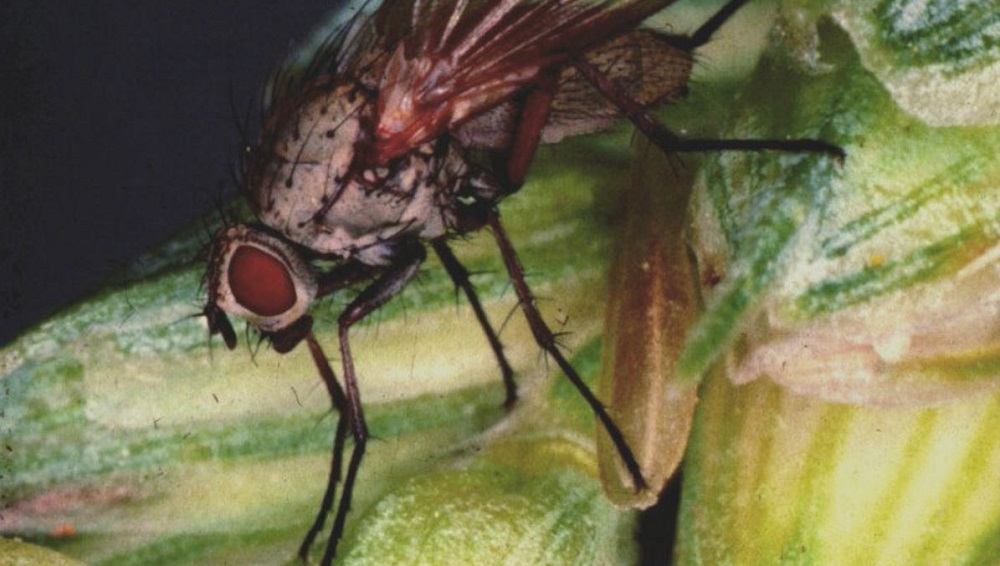- Home
- Knowledge library
- How to manage wheat bulb fly risk in cereals
How to manage wheat bulb fly risk in cereals
With spray options withdrawn, wheat bulb fly (Delia coarctata) has become more of a challenge to manage. However, a careful combination of cultural control and, in some circumstances, seed treatments can help stem the damage caused by this pest.
Why wheat bulb fly is a serious pest
Although not abundant every year, wheat bulb fly is one of the most serious pests of wheat, especially in the east of the UK. Despite its name, the pest affects all cereals, with the exception of oats.
At present, chemical control is limited to seed treatments and these are only effective in limited situations. As a result, management relies heavily on integrated pest management (IPM).
A single wheat bulb fly larva can attack multiple shoots. Plants with a single shoot during egg hatch are the most vulnerable and may die.
How to manage wheat bulb fly without pesticides
In the absence of authorised spray chemistry, focus should be on the reduction of pest pressure and enhancing a crop’s ability to withstand damage. In particular, it is important to ensure suitable tiller density at the time of wheat bulb fly attack. Crops often produce more shoots by growth stage 30 than are required to achieve potential yield. These excess shoots can be ‘sacrificed’ to the pest with no economic impact on the crop.
Factors associated with increased wheat bulb fly risk
- Wheat bulb fly attacks all cereals, with the exception of oats
- Late-sown winter cereal crops (November or later), which have fewer excess shoots at the time of egg hatch (January to March)
- Early-sown spring cereal crops (before April)
- Crops sown in higher-risk regions (especially eastern England)
- Late cereal harvest (more time for flies to feed and mature their eggs)
- Bare soil during egg-laying period, including freshly cultivated soil and exposed soil between row crops
- Organic soils (associated with relatively high egg densities)
Non-chemical control
Avoid bare ground prior to drilling cereals. Consider the use of suitable cover (e.g. mustard) to reduce the bare-ground period. Delay cultivation until after egg laying. Drill winter crops as early as practical. Avoid deep drilling. Increase seed rates. Top-dress early to promote crop recovery.
Note: Ground beetles and their larvae predate wheat bulb fly eggs and small rove beetles parasitise wheat bulb fly larvae.
Learn how to encourage populations of natural enemies
Use of seed treatments to control wheat bulb fly
Wheat bulb fly pressure at which impacts on yield might be expected is 250 eggs/m2 for crops sown before November and 100 eggs/m2 for crops sown between November to December. Later-sown winter crops and early-sown spring crops (before April) are usually the most vulnerable. Although the actual damage threshold varies considerably, the simple rule of thumb is the greater the number of tillers at the time of attack, the lower the risk of economic damage.
The only chemicals authorised for use against wheat bulb fly are in the form of seed treatments. The pest is not associated with insecticide resistance. The time between drilling and pest attack is particularly critical to seed-treatment efficacy.
Seed-treatment thresholds
- Early-sown wheat crops (before November) are unlikely to benefit from seed treatments, which lack persistence to offer full protection. Excess shoot production also makes these crops more resilient
- For late-sown wheat crops (November to December), consider seed treatments where populations exceed 100 eggs/m2
- For very late-sown crops (January), consider seed treatments irrespective of the population size (unless no eggs are present)
Note: Drill treated seed at the recommended depth of 2.4–4.0 cm in a firm, even seedbed. Signal 300 ES (cypermethrin) seed treatment must only be applied to cereal seed sown in the autumn/winter. Treated seed must not be sown after 31 January, as this is defined as the end of the winter period by CRD.
How to estimate wheat bulb fly pressure
The primary method for risk determination is soil sampling, egg extraction and counting. This process is labour-intensive, requires the use of bulky extraction equipment and taxonomic expertise for egg identification. It can only be undertaken by a specialised laboratory.
A flotation method (Salt and Hollick) is used to sieve fly eggs from soil samples. When immersed in saturated magnesium sulphate, eggs (due to their density) float from the sieve to the solution’s surface. Eggs are collected on filter paper and the species present identified under a microscope. To identify the species present, experts look at characteristic features, such as the size, shape, and texture eggs.
The autumn survey of wheat bulb fly took soil samples in September from 30 fields prone to attack (split equally across eastern and northern England) and calculated the number of wheat bulb fly eggs/m².
However, the annual survey was relatively costly and time consuming. It was also based on relatively few sites. Following a cost-benefit analysis and several relatively low-risk years for the pest, a decision was made to stop the survey after the 2023–24 growing season.
What was the wheat bulb fly survey?
It is also useful to assess the crop for deadheart symptoms. Where found, examine plant samples to determine the number of larvae. Use this information, along with any egg-count data, to build an understanding of local pest pressures.
 ADAS
ADAS
Topics:
Sectors:
Tags:

